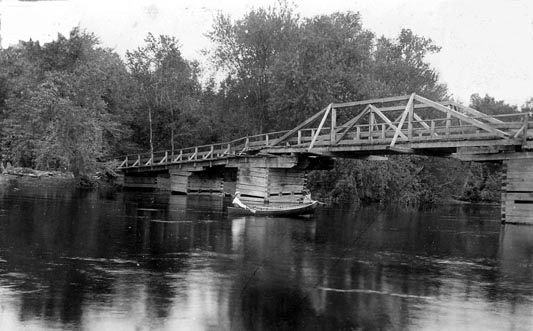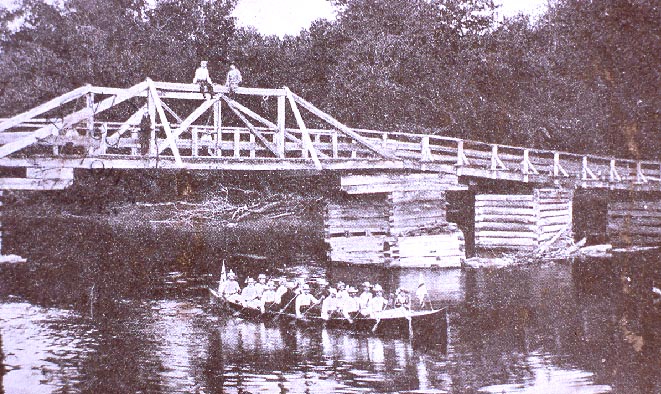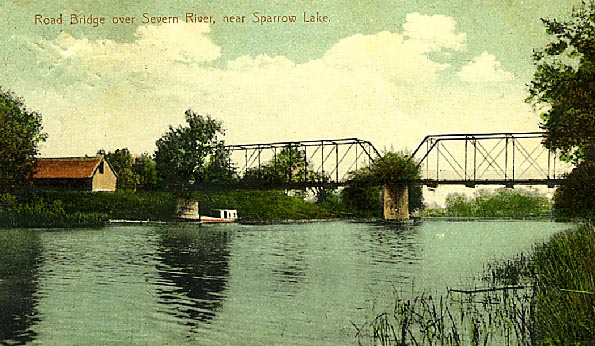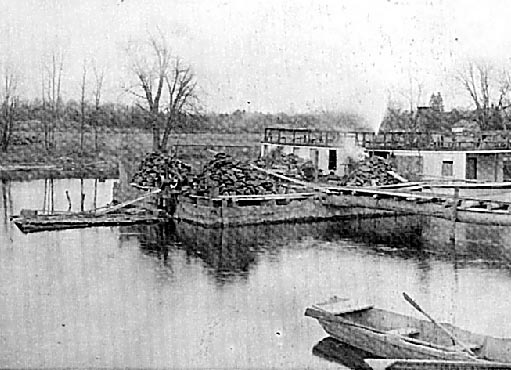by James Stanton
The first bridge on the Severn River at Hamlet was a simple wooden affair on pontoons, built in 1881, not at the present “blue bridge” location, but a half-mile downstream at Norman Bennett’s farm. Two years later, it was replaced by another wooden bridge built on stone-filled cribs. In 1886, when W.P. Christie launched his towboat, Pocahontas, to haul logs up the river to his mill at Severn Bridge, he found Bennett’s bridge still too low for his purpose. So in that same year, the cribs were raised 3 meters to permit passage of the Pocahontas.
In 1886, when W.P. Christie launched his towboat, Pocahontas, to haul logs up the river to his mill at Severn Bridge, he found Bennett’s bridge still too low for his purpose. So in that same year, the cribs were raised 3 meters to permit passage of the Pocahontas. This “war canoe” from Orillia had lots of headroom to pass through!
This “war canoe” from Orillia had lots of headroom to pass through! In 1904-5, a fixed, double-span steel bridge replaced the old wooden structure at a cost of $6,800, shared by the province and Simcoe County. This bridge served for ten years, but by 1914 a new project of a fully navigable waterway on the Severn created the need for yet another replacement bridge. Parts of the old concrete abutments are still visible on the shore.
In 1904-5, a fixed, double-span steel bridge replaced the old wooden structure at a cost of $6,800, shared by the province and Simcoe County. This bridge served for ten years, but by 1914 a new project of a fully navigable waterway on the Severn created the need for yet another replacement bridge. Parts of the old concrete abutments are still visible on the shore. The old spans were to be dismantled and the road extended along the east bank of the river to Whitesides, where a new swing bridge was planned. Work on the piers was begun in 1915, but, like many projects on the canal, it was halted because of a labour shortage during the war. The job was restarted in the summer of 1922 with the erection of steelwork for a 200-foot swing bridge on the west side. Here is work being done on the pivot pier, with Bennett’s steamer G-Whiz behind the scows.
The old spans were to be dismantled and the road extended along the east bank of the river to Whitesides, where a new swing bridge was planned. Work on the piers was begun in 1915, but, like many projects on the canal, it was halted because of a labour shortage during the war. The job was restarted in the summer of 1922 with the erection of steelwork for a 200-foot swing bridge on the west side. Here is work being done on the pivot pier, with Bennett’s steamer G-Whiz behind the scows. The east span was ingeniously salvaged from the old Bennett’s bridge. The Dominion Bridge Co., at a cost of only $850, moved the complete 103-foot section to become part of the new bridge! The span was placed on two scows positioned underneath, then, with the aid of a steam tug, pushed upstream to rest on newly constructed abutments beside the completed swing bridge. During the interruption, the mail from Severn Bridge had to be rowed across the river. The swing bridge was in full operation by the end of August 1922. (The west half of the old Bennett’s bridge was purchased by Frank Stanton, who used the steel beams for the framework of his boathouse at Port Stanton.)
The east span was ingeniously salvaged from the old Bennett’s bridge. The Dominion Bridge Co., at a cost of only $850, moved the complete 103-foot section to become part of the new bridge! The span was placed on two scows positioned underneath, then, with the aid of a steam tug, pushed upstream to rest on newly constructed abutments beside the completed swing bridge. During the interruption, the mail from Severn Bridge had to be rowed across the river. The swing bridge was in full operation by the end of August 1922. (The west half of the old Bennett’s bridge was purchased by Frank Stanton, who used the steel beams for the framework of his boathouse at Port Stanton.)
The first bridge keeper, who was also the landowner adjacent to the new bridge, was Wm. H. Keeler. He also recorded water levels of the river. George Eason took over from Bill Keeler in 1935, followed by Isaac Bagley in 1941, and later Klaus Bonnecamp. The bridge’s first colour was brown; it was repainted olive green in 1945, and blue in 1985. Until 1962, the bridge was opened by means of a hand crank located over the centre pivot (an exhausting job on a busy Sunday night!) Since ’62 an electric motor powers the gear system which opens and closes the bridge, operated from a control cabin at the west end of the bridge.
Modern upgrades began in 2018: MuskokaRegion.com
See also Historic Bridges for more info.